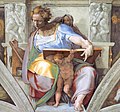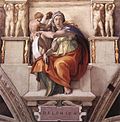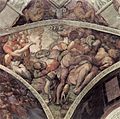Top Qs
Timeline
Chat
Perspective
Gallery of the Sistine Chapel ceiling
From Wikipedia, the free encyclopedia
Remove ads
The Sistine Chapel ceiling, painted by Michelangelo between 1508 and 1512, is one of the most renowned artworks of the High Renaissance. Central to the ceiling decoration are nine scenes from the Book of Genesis the most famous of which is The Creation of Adam, the hands of God and Adam being reproduced in countless imitations. The complex design includes multiple groups of individual figures, both clothed and nude, allowing Michelangelo to fully demonstrate his skill in depicting a wide variety of human poses, and has since served as an enormously influential reference for other artists.
This article includes a list of references, related reading, or external links, but its sources remain unclear because it lacks inline citations. (August 2017) |

Remove ads
Gallery
Iconography and Themes
The ceiling is an elaborate visual theology, focused on nine scenes from the Book of Genesis, such as the Creation of the World, the Fall of Man, and Noah's story. These are surrounded by a sequence of ignudi (nude youths), both decorative and symbolic, and perhaps symbolizing idealized man or angelic beings.
Flanking the center panels are alternating sibyls and prophets—individuals of both the Jewish and the Greco-Roman traditions—who were thought to have prophesied the arrival of the Messiah. The use of both religious and classical figures is a manifestation of Renaissance humanist concern for balancing Christian theology with classical philosophy. Over the windows are lunettes and spandrels illustrating the ancestors of Christ, bridging the Old Testament histories with the New Testament genealogy as recorded in the Gospel of Matthew.[1][2]
Remove ads
Artistic Techniques
Michelangelo painted the ceiling frescoes in the buon fresco technique, placing pigments on newly applied wet plaster, so that the color became a part of the wall surface while it dried. He created an advanced scaffold system, hung from the walls and not from the floor, so that he could paint high above the interior of the chapel. The figures, characterized by powerful muscles and dynamic movement, are a result of Michelangelo's extensive study of human anatomy, presumably due to classical sculpture and cadaver dissections he performed during his youth.[3]
Technical Challenges reflected in the Gallery
Summarize
Perspective
Michelangelo encountered a number of technical issues in painting the gallery images of the ceiling, specifically with the fresco medium and the shape of the chapel vault. Pigments had to be applied on freshly spread wet plaster according to the buon fresco method, which hardened quickly, requiring accurate timing and speedy execution to finish sections designated as giornate. This restriction made it necessary for Michelangelo to plan every panel's composition carefully, frequently working in small sections in order to preserve color continuity and prevent visible joints.[4]
Moreover, the curvature of the ceiling created challenges in perspective and foreshortening. In order to make figures look proportional and natural from the chapel floor, Michelangelo used sophisticated methods of optical correction, bending forms slightly to offset visual distortion from the viewer's position below. Parts also show the artist testing scale and stance for greatest dramatic effect within the limited space.
These technical aspects are seen in the gallery photographs, in which infirmities of detail and the overlapping of painted plaster illustrate the intricate process of fresco application on an architectural vault.
Remove ads
Photographic and Digital Documentation of the Gallery
In recent times, the Sistine Chapel ceiling gallery photographs have been well-documented with sophisticated photographic and digital methods. High-resolution photography, as well as ultraviolet and infrared photography, has been utilized to uncover the hidden details invisible to the human eye, including preparatory drawings under the paint as well as restoration layers from previous work.
Virtual digital mosaics and 3D modeling have enabled researchers and the public to view virtually the artwork on the ceiling, overcoming physical constraints of seeing the frescoes from the chapel floor. Such technologies enable close observation of Michelangelo's brush strokes, coloration, and composition methods while helping with conservation through tracking the condition of the frescoes with time.[5]
Experiences such as the Vatican's Sistine Chapel Virtual Reality venture deliver immersed access to the gallery photos, allowing users across the globe to enjoy the scale and complexity of Michelangelo's work in unprecedented resolution.[6]
Remove ads
Biblical narratives
Summarize
Perspective
Along the centre of the ceiling are nine scenes depicting the Story of Creation, the Downfall of Humanity and the Story of Noah as told in the Book of Genesis.
- The First Day of Creation, God divides light from Darkness. This was the final narrative to be painted.
- Detail of the figure of God, which was painted by Michelangelo in a single day and may represent Michelangelo himself, painting the ceiling
- To the left, God creates the Earth and, to the right, God creates the Sun to light the day and the Moon to light the night.
- God separating the waters from the heavens. (Context)
- Separating the waters (detail)
- The Creation of Adam shows God giving life to the first man, while Eve, the first woman, watches from beneath his cloak.
- Detail of God from The Creation of Adam
- The Creation of Eve is based on a sculpture in Bologna.
- The Downfall of Adam and Eve and their Expulsion from the Garden of Eden. Two episodes are combined in a single frame.
- Drunkenness of Noah
- Noah's Ark floats in the background while people struggle to escape the rising water of the Great Flood.
- Detail from the scene of the Great Flood
- The sacrifice of Noah after the Flood (in context, before restoration). This picture is thought by some to represent The sacrifices of Cain and Abel.
- Sacrifice of Noah (post-restoration. Detail)
Prophets and Sibyls
The Prophets of Israel and the Sibyls of the pagan world foretold the coming of the Messiah. Both have been included by Michelangelo as a sign that the Messiah (Jesus Christ) was to come not just for the Jews but also for the Gentiles (non-Jewish people).
- Jeremiah lamenting the fall of Jerusalem
- Ezekiel hears the word of the Lord.
- The prophet Jonah
- The Cumaean Sibyl
- The Erythraean Sibyl
- The Persian Sibyl
- The Delphic Sibyl
- The Libyan Sibyl
- Detail of the Delphic Sibyl
Pendentives
The four corner pendentives show violent episodes in which the People of Israel were rescued from enemies, or from their own sinful ways.
- Haman's punishment
Ancestors
The ancestors of Jesus are listed in the Biblical books of Matthew and Luke. This is the first known large painted series, although they were often shown in stained glass. See Tree of Jesse. Although each picture has a title, the characters cannot be positively identified.
- Achim / Eliud
- Aminadab
- Asa / Jehosaphat / Joram
- Azor / Sadoch
- Eleazar / Mathan
- Hezekiah / Manasseh / Amon
- Jacob / Joseph
- Jesse / David / Solomon
- Josiah / Jechoniah / Sheatiel
- Naason
- Rehoboam / Abijah
- Salmon / Boaz / Obed
- Uzziah / Jotham / Ahaz
- Zerubbabel / Abiud / Eliakim
- Detail of the Achim lunette
- Detail of the Asa, Jehosaphat and Joram lunette
- Detail from the Eleazar lunette
- Detail of the Ezechias lunette
- Detail of the Salmon lunette
Spandrels
Above the windows are a series of families with young children. The children may represent particular children who are mentioned in the Bible, such as Isaac and Samuel. The composition of many of the pictures is similar to that found in depictions of the Holy Family resting on the Flight into Egypt.
- In the Salmon spandrel a woman is making a garment while her child looks on.
- In the Ozias spandrel a young child is attempting to breast feed from his exhausted-looking mother, who clasps a round loaf in her hand.
- Jesse spandrel, before restoration
- Jesse spandrel, after restoration. In this spandrel, a young woman who may represent the Virgin Mary gazes out with a prophetic expression. The details of her eyes were removed in the recent restoration.
- The Ezechias spandrel shows a small child gazing out of the picture.
Ignudi
The Ignudi that surround the narrative scenes may show the perfection of Humanity, or may represent angels. They were often imitated by other artists.
- The Drunkenness of Noah group
- The Sacrifice of Noah group
- Above the Erithraean Sibyl
- To the right of "Isaiah"
- The Creation of Eve group
- Above the Cumean Sibyl
- The Separating the Waters group
- The great muscularity of the lower back of this figure suggests that he was a stonemason.
- The First Day of Creation group
- Above Jeremiah. This figure is one of the most reproduced on the ceiling.
- Above Libyan Sibyl
Shields
There are 10 shields (medallions) representing violent episodes in the history of Israel.
- 'The Death of Uriah'
- Detail of 'The Idol of Baal'
Remove ads
See also
References
Sources
External links
Wikiwand - on
Seamless Wikipedia browsing. On steroids.
Remove ads









































































